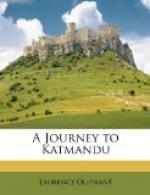The present policy of the Nepaul government is to keep the roads by which their country is approached in as impassable a state as possible, vainly imagining that, in case of a war, the badness of the roads would offer an insuperable obstacle to our progress, and compel us to relinquish any attempt to penetrate to Katmandu. This delusion ought to have been dispelled by the occupation of Muckwanpore by Sir David Ochterlony; not that it is a contingency they need take much trouble to provide against, since it would never be worth our while to do more than take possession of the Terai.
The present state of the roads renders it impossible for goods to be conveyed into Nepaul, except upon men’s backs; and as the traffic would be considerable in various articles of commerce, the prosperity and wealth of the country would be incalculably increased by an improvement in the means of transit.
Jung Bahadoor is quite alive to the real state of the case, and sees at once the absurdity of the policy pursued by the Nepaul government, but he feels that any innovation of the sort would be too unpopular for him to attempt in his present position. His recently imbibed liberal notions coincide but little with the cramped ideas of a semi-barbarous durbar. He is well aware that neither bad roads, troops, nor any other obstacle that he could oppose to our advance, would avail in case of our invading Nepaul. His feeling as regards a war with the British was not inaptly expressed in a remark he once made to me,—“If a cat is pushed into a corner it will fly at an elephant, but it will always try to keep out of the corner as long as possible.”
At Bhimphede, where we arrived about mid-day, I dismounted from the elephant on which I had journeyed comfortably for 200 miles, and for which I had begun to feel quite an affection, and was soon high up the precipitous ascent of the Cheesapany pass. It crosses a mountain which rises nearly 2000 feet above the village at its base; the path is so steep that a horse can barely scramble up it; and the ascent of the Rigi, in Switzerland, seemed a mere nothing in comparison: this pass in its turn is not nearly so steep as the Chandernagiri, which is the last pass before you descend into the valley of Katmandu.
Having so much mountain work before me, I determined on walking the rest of the journey, that being the most satisfactory and enjoyable way of travelling across a highland country and viewing its scenery; my companion betook himself to a cot or dandy swung on a pole, preferring that method of getting carried over the hills to the one in general use amongst the natives, which I imagine is peculiar to Nepaul. An open-mouthed conical basket, like that of the Parisian chiffonnier, but with contents in some respects different, since this contains the traveller and not the shreds of his exploded journal, is fastened upon the back of a bearer by a strap across his forehead and two others over his shoulders; the occupant sits with his legs over the rim of the basket, and his back almost resting against the head of his bearer, who, bending forward under the weight of his load, and grasping a long stick, looks like some decrepit old man—a delusion which vanishes the instant you commence the ascent of a mountain by his side, when his endurance and vigour astonish you, if they do not knock you up.




